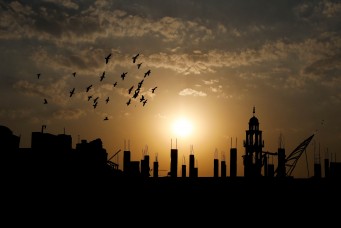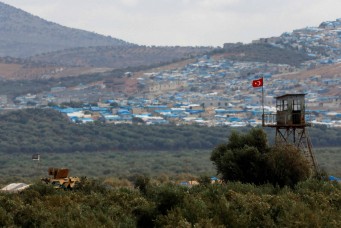Russia, Palmyra, and the Syrian Kaleidoscope
Long-term stability in Syria requires a process of national self-determination that allows citizens to freely express how they wish to configure their sovereignty and be governed.
The most useful analogy to describe the situation in Syria that keeps changing by the week is that of a kaleidoscope. With every turn, the elements comprising the image within the kaleidoscope change shape, place, and color—but they always end up in some kind of balanced relationship that gives the whole image integrity, symmetry, and some temporary permanence. This is Syria today with its dozens of major political and military elements that change positions but always result in some kind of temporary balance of power.
This has been going on for over five years now, suggesting that this is a defining rather than an occasional aspect of the conflicts playing themselves out in the country. The latest twist has seen the Russian armed forces partially pull out of the country, and the combined Syrian-Russian militaries liberate Palmyra from the control of “Islamic State” (IS, or Daesh).
This opens the way for Russian-, Iranian-, and Hezbollah-backed Syrian troops and irregular militias to keep moving north and northeast, eventually to liberate Dayr Al-Zawr and Al-Raqqah. This triggers new possibilities that others in Syria must react to, including most importantly whether Syrians in the northeast would welcome back the foreign-buttressed government in Damascus with open arms, or resist it and instead seek to forge a new order of governance based on the will of the people who live there.
This reminds us of the multiple concentric circles of elements that make up the Syrian national kaleidoscope, including, most notably (take a deep breath here): some pro-regime Syrians and many anti-regime Syrians, remnants of IS, the powerful Al-Qaeda affiliate Jabhat Al-Nusra, Ahrar Al-Sham and other strong Islamist rebel groups, Free Syrian Army elements, assorted Kurdish political and armed groups (some of which already announced plans for an autonomous Kurdish region in the north), local tribal forces that emerge and vanish as the situation demands, Turkish and Iranian groups and allies, American and other foreign special forces that occasionally strike inside Syria, half a dozen foreign air forces that attack half a dozen different groups in the country, and another half a dozen supply routes from regional countries that funnel money, arms, logistical support, and occasional fighters into Syria’s wars.
All this happens alongside equally important dynamics beyond the country’s borders: The United Nations leads a heartfelt negotiating effort in Geneva that aims to initiate a political transition that the main parties clearly cannot possibly agree on today; the United States and Russia meet regularly to define some major elements of a desired diplomatic end to the war, without any certainty that the warring parties on the ground will fall in line; and Saudi Arabia continues to put together a pan-Islamic military force from several dozen countries to fight against terrorism threats in the region, presumably including IS in Syria and Iraq.
These and other elements constantly adjust and rebalance themselves, leaving the country in some state of equilibrium that—to date—has prevented any one party from fully defeating its multiple foes. The resulting state of constant war, often localized or low intensity, has ravaged the country and doomed it to perhaps decades of tension, underdevelopment, and human suffering and dislocation. The warring parties seem not to care, and keep fighting, aiming to hold their positions and maintain their incumbency to the greatest extent possible.
The recent Russian military moves and the liberation of Palmyra clearly reinforce the Assad government’s sense of confidence and strength; these are real in the immediate sense, but they are also illusory because they fully depend on the massive external support Damascus enjoys. Presumably, sophisticated analysts among Tehran, Moscow, and Hezbollah understand that artificially propping up a weak Syrian government with massive external military and economic aid is not a realistic long-term option, which makes the diplomatic option more attractive. But diplomatic breakthroughs are out of the question now if they require Assad to accept his phased departure and a more inclusive and democratic governance system that ends nearly half a century of Baathist-Alawite-Assad family-dominated rule. The path to long-term stability in Syria requires a process of national self-determination that allows the citizens of the country to freely express how they wish to configure their sovereignty and be governed, which is beyond reach today given the nature of fragmented power, constant warfare, and the many external players involved.
So we should probably expect continuation of the current trend of Syria’s ever changing kaleidoscopic warfare and diplomacy, with the likely exception of a major military effort to break up IS’s home base in northern Syria that would set off a wild scramble for control of that region, and another turn of the kaleidoscope.
Rami G. Khouri is published twice weekly in the Daily Star. He was founding director and now senior policy fellow of the Issam Fares Institute for Public Policy and International Affairs at the American University of Beirut. On Twitter: @RamiKhouri.
Copyright ©2016 Rami G. Khouri — distributed by Agence Global




